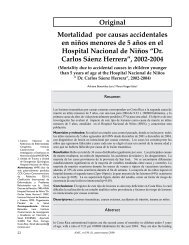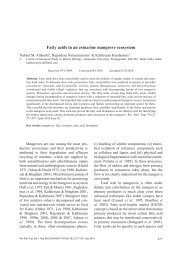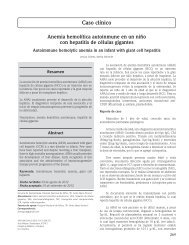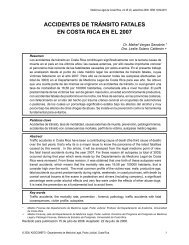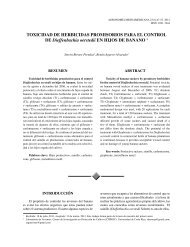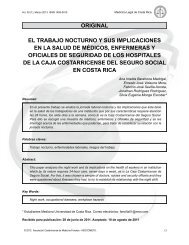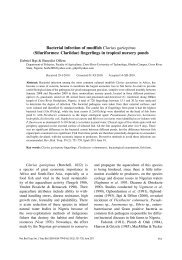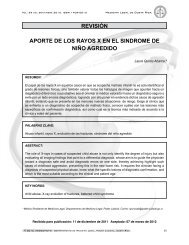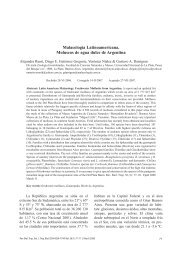Acoustic courtship songs in males of the fruit fly ... - SciELO
Acoustic courtship songs in males of the fruit fly ... - SciELO
Acoustic courtship songs in males of the fruit fly ... - SciELO
You also want an ePaper? Increase the reach of your titles
YUMPU automatically turns print PDFs into web optimized ePapers that Google loves.
<strong>Acoustic</strong> <strong>courtship</strong> <strong>songs</strong> <strong>in</strong> <strong>males</strong> <strong>of</strong> <strong>the</strong> <strong>fruit</strong> <strong>fly</strong> Anastrepha ludens<br />
(Diptera: Tephritidae) associated with geography,<br />
mass rear<strong>in</strong>g and <strong>courtship</strong> success<br />
R.D. Briceño 1 , Ma. del Refugio Hernández 2 , D<strong>in</strong>a Orozco 2 & Paul Hanson 1<br />
1. Escuela de Biología, Universidad de Costa Rica, Ciudad Universitaria Rodrigo Facio, 11501-2060, San Pedro de<br />
Montes de Oca, San José, Costa Rica; rbriceno@biologia.ucr.ac.cr<br />
2. Programa Moscamed Moscafrut, Desarrollo de Metodos Central Poniente No. 14 altos, Esq. 2ª Avenida Sur, CP 30700<br />
Tapachula, Chiapas, Mexico; dorozco1@prodigy.net.mx<br />
Received 26-iii-2008. Corrected 10-vi-2009. Accepted 23-vii-2009.<br />
Abstract: The Sterile Insect Technique (SIT) has been used successfully to control or eradicate <strong>fruit</strong> flies. The<br />
commonly observed <strong>in</strong>feriority <strong>of</strong> mass-reared <strong>males</strong>, compared with wild <strong>males</strong>, when <strong>the</strong>y are paired with wild<br />
fe<strong>males</strong>, is apparently due to <strong>the</strong>ir <strong>in</strong>adequate <strong>courtship</strong>. Anastrepha ludens <strong>males</strong> produce two types <strong>of</strong> w<strong>in</strong>g<br />
vibration dur<strong>in</strong>g <strong>courtship</strong> and mat<strong>in</strong>g, <strong>the</strong> “call<strong>in</strong>g sound” and <strong>the</strong> “premat<strong>in</strong>g or precopulatory sound”. There<br />
were clear differences <strong>in</strong> <strong>the</strong> call<strong>in</strong>g <strong>songs</strong> between successful and unsuccessful <strong>courtship</strong>s <strong>in</strong> sterile (irradiated)<br />
and fertile Mexican flies. Among sterile flies, successful <strong>males</strong> produce longer buzzes, shorter <strong>in</strong>terpulses and<br />
a higher power spectrum <strong>in</strong> <strong>the</strong> signal. Fertile flies showed <strong>the</strong> same trend. For mat<strong>in</strong>g <strong>songs</strong> a significant difference<br />
occurred <strong>in</strong> two parameters: power spectrum between sterile and fertile flies with respect to <strong>the</strong> type<br />
<strong>of</strong> song, and <strong>the</strong> signal duration and <strong>in</strong>tensity were greater <strong>in</strong> non-irradiated flies. Call<strong>in</strong>g <strong>songs</strong> <strong>of</strong> wild flies<br />
compared with laboratory grown flies from Mexico had shorter <strong>in</strong>terpulses, longer pulses, and a greater power<br />
spectrum. However, <strong>in</strong> <strong>the</strong> case <strong>of</strong> premat<strong>in</strong>g <strong>songs</strong>, <strong>the</strong> only difference was <strong>in</strong> <strong>the</strong> <strong>in</strong>tensity, which was significantly<br />
greater <strong>in</strong> wild <strong>males</strong>. An unexpected result was not observ<strong>in</strong>g pulses dur<strong>in</strong>g pheromone deposition<br />
<strong>in</strong> wild <strong>males</strong> from Costa Rica. Compar<strong>in</strong>g <strong>the</strong> premat<strong>in</strong>g <strong>songs</strong> <strong>of</strong> wild flies from Costa Rica and Mexico, no<br />
significant differences were observed <strong>in</strong> <strong>the</strong> duration, and <strong>the</strong> <strong>in</strong>tensity <strong>of</strong> <strong>the</strong> signal was slightly greater <strong>in</strong> flies<br />
from Mexico. Rev. Biol. Trop. 57 (Suppl. 1): 257-265. Epub 2009 November 30.<br />
Key words: <strong>fruit</strong> flies, Tephritide, Anastrepha, sound production, <strong>courtship</strong>, mass rear<strong>in</strong>g, Mexico, Costa Rica.<br />
Fruit flies are <strong>of</strong> major economic importance<br />
<strong>in</strong> nearly all tropical, subtropical and<br />
some temperate countries worldwide. Several<br />
species have spread around <strong>the</strong> world and some<br />
have <strong>in</strong>creased significantly <strong>in</strong> importance.<br />
Over <strong>the</strong> last decades, <strong>the</strong>ir biology and management<br />
have received national and <strong>in</strong>ternational<br />
attention (Calk<strong>in</strong>s 1984)<br />
The success <strong>in</strong> controll<strong>in</strong>g pest populations<br />
<strong>of</strong> <strong>fruit</strong> flies us<strong>in</strong>g mass reared sterile<br />
<strong>males</strong> depends on <strong>the</strong> abilities <strong>of</strong> <strong>the</strong>se <strong>males</strong><br />
to successfully <strong>in</strong>duce wild fe<strong>males</strong> to copulate<br />
with <strong>the</strong>m. Current understand<strong>in</strong>g <strong>of</strong> why<br />
some <strong>courtship</strong>s result <strong>in</strong> copulation, while<br />
<strong>the</strong> majority do not, is only fragmentary.<br />
The commonly observed <strong>in</strong>feriority <strong>of</strong> massreared<br />
<strong>males</strong>, compared with wild <strong>males</strong>,<br />
when <strong>the</strong>y are paired with wild fe<strong>males</strong><br />
(Rossler 1975b, Calk<strong>in</strong>s 1984, Shelly et<br />
al. 1994, Hendrichs et al. 1996, Briceño &<br />
Eberhard 1998) is apparently due to <strong>the</strong>ir<br />
<strong>in</strong>adequate <strong>courtship</strong> per se, ra<strong>the</strong>r than to<br />
<strong>in</strong>ferior abilities to f<strong>in</strong>d and attend leks; or it<br />
may be due to <strong>the</strong>ir reduced ability to attract<br />
fe<strong>males</strong> with <strong>the</strong>ir pheromones (Shelly et al.<br />
1994, Shelly & Whittier 1996, Hendrichs et<br />
al. 1996, Liimata<strong>in</strong>en et al. 1997, Lance et<br />
al. 2000).<br />
Rev. Biol. Trop. (Int. J. Trop. Biol. ISSN-0034-7744) Vol. 57 (Suppl. 1): 257-265, November 2009<br />
257
Tests and standards are needed to improve<br />
<strong>the</strong> quality <strong>of</strong> rear<strong>in</strong>g and to m<strong>in</strong>imize production<br />
costs (Boller et al. 1981). Such tests are<br />
generally conceded to give only <strong>in</strong>complete<br />
assessments (e.g. discussion at First Meet<strong>in</strong>g<br />
<strong>of</strong> Western Hemisphere Fruit Fly Work<strong>in</strong>g<br />
Group 1992, <strong>in</strong> San Jose, Costa Rica), and it is<br />
probable that <strong>fly</strong> quality is less than optimum<br />
(Hibiano & Iwahashi 1991).<br />
The Mexican <strong>fruit</strong> <strong>fly</strong>, Anastrepha ludens<br />
(Loew) is a polyphagous, frugivorous tephritid<br />
ocurr<strong>in</strong>g from Sou<strong>the</strong>rn Texas South to at<br />
least Costa Rica (Stone 1942) and is related to<br />
several o<strong>the</strong>r economically important tephritid<br />
pests such as <strong>the</strong> Mediterranean <strong>fruit</strong> <strong>fly</strong>,<br />
Ceratitis capitata (Wiedemann). Due to its<br />
economic importance and <strong>the</strong> extensive use <strong>of</strong><br />
sterile male releases for its control <strong>in</strong> Texas and<br />
Mexico, studies <strong>of</strong> <strong>the</strong> communicative qualities<br />
that make this <strong>fruit</strong> <strong>fly</strong> sexually competitive or<br />
attractive were undertaken (Burk & Calk<strong>in</strong>s<br />
1983), s<strong>in</strong>ce little is known about <strong>the</strong>se basic<br />
features <strong>of</strong> its biology (Webb et al. 1983). S<strong>in</strong>ce<br />
several species <strong>of</strong> tephritid <strong>fruit</strong> flies have<br />
been reported to produce special sounds before<br />
couple formation, one method to evaluate <strong>the</strong><br />
quality <strong>of</strong> <strong>the</strong> flies is to look for differences <strong>in</strong><br />
<strong>the</strong> song characteristics <strong>of</strong> mass reared and wild<br />
<strong>males</strong> dur<strong>in</strong>g <strong>courtship</strong>.<br />
Anastrepha ludens <strong>males</strong> produce two<br />
types <strong>of</strong> w<strong>in</strong>g vibration. The male first applies<br />
<strong>the</strong> anal pheromone to <strong>the</strong> substrate, dur<strong>in</strong>g<br />
this time he alternately produces short bursts<br />
<strong>of</strong> rapid w<strong>in</strong>g vibration, accompanied by a forward-backward<br />
movement <strong>of</strong> <strong>the</strong> w<strong>in</strong>gs, thus<br />
produc<strong>in</strong>g a sound each time he rapidly deflects<br />
his w<strong>in</strong>g anteriorly; this is <strong>the</strong> “call<strong>in</strong>g sound”.<br />
Once he has leapt forward and landed on <strong>the</strong><br />
female, he turns and aligns himself on her dorsum<br />
with his mouthparts extended and starts to<br />
produce a relatively constant, susta<strong>in</strong>ed sound,<br />
<strong>the</strong> “premat<strong>in</strong>g or precopulatory sound”. The<br />
purpose <strong>of</strong> <strong>the</strong>se sounds is unknown, but it has<br />
been proposed that <strong>the</strong> function <strong>of</strong> <strong>the</strong> movements<br />
is to waft pheromones <strong>in</strong>to <strong>the</strong> airstream<br />
toward an approach<strong>in</strong>g female (e.g. Siv<strong>in</strong>sky et<br />
al. 1984) s<strong>in</strong>ce <strong>the</strong>y are <strong>of</strong>ten correlated with<br />
pheromone release. It has also been proposed<br />
that it may play a role <strong>in</strong> form<strong>in</strong>g aggregations,<br />
<strong>in</strong> establish<strong>in</strong>g male territories, <strong>in</strong> attract<strong>in</strong>g<br />
fe<strong>males</strong> or <strong>in</strong> provid<strong>in</strong>g a species recognition<br />
cue. Circumstantial evidence also suggests that<br />
a female that is judg<strong>in</strong>g male quality may use<br />
sound <strong>in</strong>tensity to decide whe<strong>the</strong>r mounted<br />
<strong>males</strong> will be allowed to copulate (Burke &<br />
Webb 1983, Webb et al. 1983). Similar <strong>songs</strong><br />
produced by African drosophilids, Zaprionus<br />
spp., are also considered factors <strong>in</strong> <strong>in</strong>trasexual<br />
selection (Bennet-Clark et al. 1980). There<br />
are thus as yet no conclusive demonstrations<br />
that any sounds are functionally important <strong>in</strong><br />
<strong>courtship</strong>.<br />
The present research exam<strong>in</strong>es <strong>the</strong> possibility<br />
that mass rear<strong>in</strong>g results <strong>in</strong> changes <strong>in</strong><br />
<strong>the</strong> temporal and spectral characteristics <strong>of</strong> <strong>the</strong><br />
call<strong>in</strong>g and precopulatory sounds <strong>of</strong> successful<br />
and unsuccessful <strong>males</strong> <strong>of</strong> three stra<strong>in</strong>s <strong>of</strong> flies:<br />
wild flies from Costa Rica and Mexico, and<br />
laboratory grown flies. Songs <strong>of</strong> radiated and<br />
non-radiated flies are also compared.<br />
MATERIALS AND METHODS<br />
Mass reared flies (fertile and sterile) from<br />
Mexico were obta<strong>in</strong>ed as pupae from a stra<strong>in</strong><br />
which had been <strong>in</strong>itiated us<strong>in</strong>g wild flies and<br />
ma<strong>in</strong>ta<strong>in</strong>ed for 13 years <strong>in</strong> <strong>the</strong> Mosca<strong>fruit</strong><br />
Plant <strong>of</strong> Metapa, Domínguez, Chiapas, Mexico.<br />
Wild flies from Mexico were raised from larvae<br />
that emerged from <strong>in</strong>fested sour orange<br />
(Citrus aurantium) collected near Soconusco<br />
Chiapas, México, dur<strong>in</strong>g October, November<br />
and December 2006. Costa Rican wild flies<br />
were collected from <strong>in</strong>fested orange <strong>fruit</strong>s <strong>in</strong><br />
April-March 2006 at <strong>the</strong> Estación Experimental<br />
Fabio Baudrit near Alajuela. Third <strong>in</strong>star larvae<br />
were placed <strong>in</strong> vermiculite (Strong-lite®,<br />
Products Corp. Seneca lll<strong>in</strong>ois) with humidity<br />
<strong>of</strong> 23±1ºC dur<strong>in</strong>g 14 days, <strong>the</strong> required time for<br />
pupal maturation. The pupae were later placed<br />
<strong>in</strong> wooden cages boxes (30x30x30cm) covered<br />
with mesh until emergence. When sexually<br />
mature, <strong>males</strong> and fe<strong>males</strong> were placed <strong>in</strong> separate<br />
cages and ma<strong>in</strong>ta<strong>in</strong>ed <strong>in</strong> laboratory conditions<br />
under a photoperiod <strong>of</strong> 12L:12D (550<br />
±50lux), 25±1°C and 65±5% relative humidity.<br />
258 Rev. Biol. Trop. (Int. J. Trop. Biol. ISSN-0034-7744) Vol. 57 (Suppl. 1): 257-265, November 2009
Adult flies <strong>of</strong> all stra<strong>in</strong>s were separated by<br />
sexes when <strong>the</strong>y were less than two days old<br />
and fed a mixture <strong>of</strong> sugar and prote<strong>in</strong> hydrolysate.<br />
Male and female pairs <strong>of</strong> wild flies,<br />
whose sexual maturation is more delayed, were<br />
placed toge<strong>the</strong>r only after <strong>the</strong>y were 15 days<br />
old. The irradiation was carried out on non wild<br />
pupae 48h before emergence (color <strong>of</strong> imag<strong>in</strong>al<br />
disks: emergence process =5% -2=60%) <strong>in</strong> an<br />
irradiador JS 7400 series IR99 at a dose <strong>of</strong> 140<br />
Greys. Non irradiated laboratory flies served<br />
as controls.<br />
Male-female pairs <strong>of</strong> mass reared flies<br />
(fertile and sterile) were placed toge<strong>the</strong>r for<br />
videotap<strong>in</strong>g when <strong>the</strong>y were 10 to 12 days old;<br />
male-female pairs <strong>of</strong> wild flies were placed<br />
toge<strong>the</strong>r when <strong>the</strong>y were 18 to 20 days old.<br />
Pairs <strong>of</strong> flies <strong>in</strong> Costa Rica were videotaped <strong>in</strong><br />
13.7cm diameter and 1.8cm deep mat<strong>in</strong>g chamber<br />
(clear Petri dishes) on a glass table us<strong>in</strong>g<br />
a Sony DCR.TRV80 digital camera equipped<br />
with +6 close-up lenses. The camera was below<br />
<strong>the</strong> table, allow<strong>in</strong>g record<strong>in</strong>g from below (most<br />
<strong>courtship</strong> occurred on <strong>the</strong> ceil<strong>in</strong>g <strong>of</strong> <strong>the</strong> mat<strong>in</strong>g<br />
chamber). A small microphone (Sennheiser<br />
System MZK 80ZU) was <strong>in</strong>serted through a<br />
hole <strong>in</strong>side <strong>the</strong> chamber and connected to <strong>the</strong><br />
camera. Pairs <strong>in</strong> Mexico were videotaped us<strong>in</strong>g<br />
a Sony DCR-TRV820P digital camera <strong>in</strong> a clear<br />
plastic cyl<strong>in</strong>der 100x15mm. Each afternoon,<br />
ten m<strong>in</strong>utes after a male was released <strong>in</strong> a conta<strong>in</strong>er,<br />
a female was <strong>in</strong>troduced and <strong>the</strong> record<strong>in</strong>g<br />
was carried out for 60 to 120m<strong>in</strong> maximum<br />
or until copulation was observed. A total <strong>of</strong> 30<br />
record<strong>in</strong>gs were made per treatment.<br />
Record<strong>in</strong>gs <strong>of</strong> sounds were imported from<br />
video record<strong>in</strong>gs <strong>in</strong>to a Pentium 4 computer<br />
us<strong>in</strong>g a SoundMax Digital audio card 5.0 (16<br />
bits). The mean duration <strong>of</strong> buzzes and <strong>the</strong><br />
<strong>in</strong>terval between buzzes were measured us<strong>in</strong>g<br />
<strong>the</strong> real time display <strong>in</strong> <strong>the</strong> Raven® program<br />
when <strong>the</strong> cursor marked <strong>the</strong> beg<strong>in</strong>n<strong>in</strong>g and <strong>the</strong><br />
end <strong>of</strong> <strong>the</strong> envelope curve <strong>in</strong> <strong>the</strong> ma<strong>in</strong> w<strong>in</strong>dow<br />
<strong>of</strong> <strong>the</strong> program. O<strong>the</strong>r characteristics that we<br />
measured were <strong>songs</strong> fundamental frequency<br />
(Hz) and <strong>the</strong> power spectrum (db).<br />
Courtship outcome was classified <strong>in</strong> three<br />
classes: no mount<strong>in</strong>g, when <strong>the</strong> male ceased<br />
court<strong>in</strong>g without attempt<strong>in</strong>g to mount <strong>the</strong><br />
female (failure to mount is <strong>of</strong>ten associated<br />
with failure <strong>of</strong> <strong>the</strong> female to align herself properly<br />
with <strong>the</strong> court<strong>in</strong>g male and to rema<strong>in</strong> still;<br />
Briceño et al. 1999, Briceño & Eberhard 2002);<br />
failed mount, when <strong>the</strong> male mounted but was<br />
dislodged when <strong>the</strong> female struggled; and successful<br />
mount, when <strong>the</strong> male mounted <strong>the</strong><br />
female and achieved genitalic contact.<br />
All statistical tests were non-parametric<br />
Mann Whitney U Test due to <strong>the</strong> highly skewed<br />
distribution <strong>of</strong> many variables. Means are presented<br />
followed by one standard deviation for<br />
illustrative purposes only.<br />
RESULTS<br />
In an attempt to understand <strong>the</strong> possible<br />
selective factors which might <strong>in</strong>fluence song<br />
characteristics, we compared several aspects<br />
<strong>of</strong> call<strong>in</strong>g and premat<strong>in</strong>g <strong>songs</strong> <strong>in</strong> <strong>courtship</strong><br />
that led to copulation as compared with those<br />
that ended <strong>in</strong> female rejection <strong>of</strong> a mount or a<br />
failure to mount <strong>in</strong> different stra<strong>in</strong>s (Tables 1,<br />
2). There were differences <strong>in</strong> <strong>the</strong> call<strong>in</strong>g <strong>songs</strong><br />
between successful and unsuccessful <strong>courtship</strong>s<br />
<strong>in</strong> sterile and fertile Mexican flies. In<br />
sterile flies a significant difference occurred <strong>in</strong><br />
<strong>the</strong> <strong>in</strong>terpulse <strong>in</strong>terval, pulse duration and maximum<br />
power; successful <strong>males</strong> produced longer<br />
buzzes, shorter <strong>in</strong>terpulses and a higher power<br />
spectrum <strong>in</strong> <strong>the</strong> signal, and fertile flies showed<br />
<strong>the</strong> same results (Table 1). No differences were<br />
found <strong>in</strong> <strong>the</strong> fundamental frequency <strong>of</strong> <strong>the</strong><br />
signal for sterile <strong>males</strong> but were significantly<br />
higher for successful fertile <strong>males</strong>. No differences<br />
were found for <strong>the</strong> two types <strong>of</strong> <strong>males</strong> <strong>in</strong><br />
<strong>the</strong> number <strong>of</strong> pulses per second. Comb<strong>in</strong><strong>in</strong>g<br />
successful and unsuccessful <strong>courtship</strong>s <strong>of</strong> both<br />
treatments, differences were observed <strong>in</strong> <strong>the</strong><br />
duration <strong>of</strong> pulses, <strong>the</strong> <strong>in</strong>tensity <strong>of</strong> <strong>the</strong> signal<br />
and <strong>the</strong> fundamental frequency, be<strong>in</strong>g greater<br />
<strong>in</strong> both cases for fertile flies.<br />
For mat<strong>in</strong>g <strong>songs</strong> a significant difference<br />
occurred <strong>in</strong> two parameters. Differences <strong>in</strong><br />
power spectrum between irradiated and nonirradiated<br />
flies were observed with respect to<br />
Rev. Biol. Trop. (Int. J. Trop. Biol. ISSN-0034-7744) Vol. 57 (Suppl. 1): 257-265, November 2009<br />
259
Table 1<br />
Call<strong>in</strong>g sound parameters <strong>in</strong> successful and unsuccessful mounts <strong>of</strong> sterile and fertile mass-reared <strong>males</strong> from Mexico<br />
Laboratory sterile Laboratory fertile Totals<br />
Unsuccessful Successful Unsuccessful Successful Lab sterile Lab fertile<br />
Duration (sec)<br />
Interpulse 1.57±1.74 0.88±0.85*** 2.20±3.10 1.28±1.69*** 1.76±2.55 1.49±1.59ns<br />
Pulse 0.15±0.10 0.17±0.11** 0.20±0.11 0.26±0.12*** 0.16±0.10 0.21±0.12***<br />
Spectral measurements<br />
Max. Power (db) 54.5±8.69 59.4±4.04*** 60.6±5.5 61.8±4.98*** 55.7±8.1 61.2±5.3***<br />
Fundamental Freq. (Hz) 142±29 141±14 ns 149.9±7.4 157.3±9.3** 142±2.9 152.4±3.4***<br />
Freq. (number/s) 0.56±0.38 0.48±0.535 ns 0.2±0.3 0.5±0.3 ns 0.55±0.4 0.4±0.35 ns<br />
n pulses 227 71 262 287 280 549<br />
Pairs 25 10 18 18 35 36<br />
*p
Table 4<br />
Premat<strong>in</strong>g sound parameters <strong>in</strong> fertile laboratory and<br />
wild <strong>males</strong> from Mexico<br />
Lab. Flies<br />
Wild Flies<br />
Duration (sec) 45.±48.3 13.5±4.7 ns<br />
Spectral measurements<br />
Max. Power (db) 67.2±2.2 70.9±1.6 *<br />
Fundamental Freq. (Hz) 146±38 148±36 ns<br />
N mounts 60 24<br />
Pairs 35 18<br />
F<strong>in</strong>ally, upon compar<strong>in</strong>g <strong>the</strong> premat<strong>in</strong>g<br />
<strong>songs</strong> <strong>of</strong> wild flies from Costa Rica and Mexico<br />
(Table 5), no significant differences were<br />
observed <strong>in</strong> <strong>the</strong> duration, and <strong>the</strong> <strong>in</strong>tensity <strong>of</strong><br />
<strong>the</strong> signal was barely different, be<strong>in</strong>g greater <strong>in</strong><br />
flies from Mexico (67.2 vs. 63.9, p
Table 5<br />
Premat<strong>in</strong>g sound parameters <strong>in</strong> fertile wild <strong>males</strong> from<br />
Mexico and Costa Rica<br />
MEXICO COSTA RICA<br />
Duration (sec) 13.5±4.7 17.5±2.3ns<br />
Max. Power (db) 67.2±4.6 63.9±3.2*<br />
Fundamental Freq. (Hz) 148±36 146±41 ns<br />
N mounts 24 48<br />
Pairs 18 60<br />
<strong>males</strong> (Bailey 1991). Sound <strong>in</strong>tensity is an<br />
important determ<strong>in</strong>ant <strong>of</strong> female acceptance <strong>in</strong><br />
<strong>the</strong> tephritid Anastrepha suspensa (Siv<strong>in</strong>ski et<br />
al. 1984, Webb et al 1976), and <strong>in</strong> phonotatic<br />
responses <strong>of</strong> female mole crickets where <strong>males</strong><br />
with call<strong>in</strong>g <strong>songs</strong> 3-5db louder attracted 17<br />
times as many fe<strong>males</strong> as <strong>males</strong> with quieter<br />
<strong>songs</strong> (Forrest 1980). Differences <strong>in</strong> <strong>the</strong> power<br />
output <strong>of</strong> precopulatory sound <strong>in</strong> mount<strong>in</strong>g<br />
<strong>males</strong> <strong>of</strong> A. ludens that were successful vs.<br />
unsuccessful <strong>in</strong> copulat<strong>in</strong>g, suggest that power<br />
output is ano<strong>the</strong>r variable that fe<strong>males</strong> may use<br />
<strong>in</strong> mak<strong>in</strong>g mat<strong>in</strong>g decisions. Ability to produce<br />
loud precopulatory sounds may reflect development<br />
<strong>of</strong> w<strong>in</strong>g musculature, affect<strong>in</strong>g both<br />
flight and attract<strong>in</strong>g ability <strong>of</strong> <strong>males</strong>. Fe<strong>males</strong><br />
that evaluate on <strong>the</strong> basis <strong>of</strong> power output<br />
might produce fitter <strong>of</strong>fpr<strong>in</strong>g. Thus <strong>the</strong> present<br />
data support <strong>the</strong> idea that song traits like sound<br />
<strong>in</strong>tensity can <strong>in</strong>fluence <strong>courtship</strong> success. Fur<strong>the</strong>rmore,<br />
this study revealed that sterile flies<br />
had <strong>songs</strong> with <strong>the</strong> shortest pulse, which might<br />
<strong>in</strong>dicate a lower fitness <strong>of</strong> <strong>the</strong>se flies compared<br />
with fertile ones. The apparent differences<br />
<strong>in</strong> sound production between successful and<br />
unsuccessful <strong>males</strong> dur<strong>in</strong>g <strong>courtship</strong> is only<br />
one <strong>of</strong> many factors that may <strong>in</strong>fluence female<br />
acceptance <strong>in</strong> A. ludens. Fur<strong>the</strong>r work will be<br />
needed to elucidate female criteria, and how<br />
<strong>the</strong>y change under mass rear<strong>in</strong>g conditions.<br />
In addition, mass rear<strong>in</strong>g <strong>of</strong> sterile <strong>males</strong><br />
has <strong>of</strong>ten been used <strong>in</strong> attempts to control<br />
pest population <strong>of</strong> medflies, and mass-reared<br />
stra<strong>in</strong>s have <strong>of</strong>ten been conserved for many<br />
years. Reproduction <strong>in</strong> <strong>the</strong>se stra<strong>in</strong>s occurs<br />
V<br />
11<br />
10<br />
Premat<strong>in</strong>g Song<br />
Premat<strong>in</strong>g Song<br />
09<br />
08<br />
07<br />
06<br />
05<br />
04<br />
03<br />
02<br />
01<br />
0<br />
-01<br />
-02<br />
-03<br />
-04<br />
-05<br />
-06<br />
-07<br />
-08<br />
-09<br />
-10<br />
0 5 10 15 20 25 30 35 40 45 50 55 s<br />
Fig 2. On <strong>the</strong> female dorsum <strong>the</strong> male starts to produce a relatively constant, susta<strong>in</strong>ed sound, <strong>the</strong> “premat<strong>in</strong>g sound”<br />
262 Rev. Biol. Trop. (Int. J. Trop. Biol. ISSN-0034-7744) Vol. 57 (Suppl. 1): 257-265, November 2009
under conditions that sharply differ from those<br />
<strong>in</strong> nature <strong>in</strong> several respects. Old mass-reared<br />
stra<strong>in</strong>s thus represent <strong>the</strong> results <strong>of</strong> <strong>in</strong>advertent<br />
experiments <strong>in</strong> which several environmental<br />
conditions have been changed. It is not obvious,<br />
however, which song traits would be more<br />
advantageous under mass rear<strong>in</strong>g conditions<br />
(Briceño et al. 2002); however, <strong>the</strong> fact that <strong>the</strong><br />
duration <strong>of</strong> <strong>the</strong> <strong>in</strong>terpulse and pulse, as well as<br />
<strong>the</strong> power spectrum, showed significant differences<br />
compared with wild flies, suggests that<br />
<strong>the</strong>se variables can also be affected by mass<br />
rear<strong>in</strong>g conditions.<br />
The negative effects <strong>of</strong> irradiation on<br />
sexual competitiveness <strong>of</strong> <strong>fruit</strong> flies are well<br />
documented (Hollbrook & Fujimoto 1970,<br />
Hooper 1972, Rossler 1975, Wong et al. 1983,<br />
Moreno et al. 1991). Lux et al. (2002) describe<br />
<strong>in</strong> detail <strong>the</strong>se negative effects on <strong>courtship</strong>.<br />
Our results suggest that sterilization could also<br />
have an <strong>in</strong>fluence on <strong>the</strong> sound production <strong>in</strong> A.<br />
ludens. Significant differences occurred <strong>in</strong> <strong>the</strong><br />
fundamental frequency, duration and amplitude<br />
<strong>of</strong> <strong>the</strong> sounds. Similar effects <strong>in</strong> sound production<br />
<strong>in</strong> Gloss<strong>in</strong>a pallidipes have been reported<br />
by Bolldorf (2005). As <strong>the</strong> sound frequency<br />
pr<strong>in</strong>cipally depends on <strong>the</strong> size and weight <strong>of</strong><br />
<strong>the</strong> <strong>in</strong>sects (Bennet-Clark 1999, Sueur 2003),<br />
<strong>the</strong> lower frequency <strong>in</strong> sterilized <strong>fruit</strong> flies may<br />
result from a larger body size or a weaker flight<br />
musculature. The fact that <strong>the</strong> development <strong>of</strong><br />
<strong>the</strong> musculature is <strong>in</strong>fluenced by irradiation<br />
(Langley & Abasa 1970) might also expla<strong>in</strong><br />
<strong>the</strong> differences <strong>in</strong> <strong>the</strong> fundamental frequency<br />
<strong>of</strong> sounds recorded <strong>in</strong> this study, as sound production<br />
is directly correlated with w<strong>in</strong>g beat<br />
frequency. The <strong>in</strong>fluence <strong>of</strong> sterilization has<br />
been demonstrated <strong>in</strong> <strong>the</strong> present work, but <strong>the</strong><br />
consequences <strong>of</strong> <strong>the</strong>se differences <strong>in</strong> sounds<br />
on <strong>fly</strong> behavior have not been shown. Future<br />
work needs to focus on determ<strong>in</strong><strong>in</strong>g useful<br />
acoustic quality control parameters, which can<br />
be applied for fitness test<strong>in</strong>g <strong>of</strong> flies.<br />
There are several reasons to expect that<br />
present-day populations <strong>of</strong> A. ludens may not<br />
have uniform <strong>courtship</strong> <strong>songs</strong>. The geographic<br />
range <strong>of</strong> <strong>the</strong> species has <strong>in</strong>creased dramatically.<br />
Thus both drift and divergence under<br />
sexual selection <strong>in</strong> geographically isolated<br />
populations may have occurred. In Drosophila<br />
mojavenses Etges et al. (2005) found significant<br />
geographical variation <strong>in</strong> mean <strong>in</strong>terpulse<br />
<strong>in</strong>terval and mean burst duration, and significant<br />
variation <strong>in</strong> mean burst duration among<br />
geographically isolated populations from Baja<br />
California and ma<strong>in</strong>land Mexico and Arizona.<br />
Thus it is not unusual to f<strong>in</strong>d <strong>the</strong>se temporal<br />
and spectral differences <strong>in</strong> isolated populations<br />
<strong>of</strong> A. ludens. Moreover, <strong>the</strong> geographical differences<br />
observed <strong>in</strong> wild flies from Costa Rica<br />
(absence <strong>of</strong> <strong>the</strong> call<strong>in</strong>g sound) (Briceño, R.D.<br />
et al. 2002) suggest possible divergence due to<br />
founder effects and divergent sexual selection<br />
<strong>in</strong> different populations.<br />
The consistent association between <strong>the</strong><br />
details <strong>of</strong> male <strong>songs</strong> and success argues <strong>in</strong><br />
favor <strong>of</strong> a possible role <strong>of</strong> sexual selection.<br />
ACKNOWLEDGMENTS<br />
We thank <strong>the</strong> Universidad de Costa Rica,<br />
<strong>the</strong> Moscamed Moscafrut Program and <strong>the</strong><br />
International Atomic Energy Agency for f<strong>in</strong>ancial<br />
support.<br />
RESUMEN<br />
La técnica estéril del <strong>in</strong>secto (SIT) se ha utilizado con<br />
éxito para controlar o para suprimir las moscas de fruta y<br />
su impacto en los cultivos. La <strong>in</strong>ferioridad comúnmente<br />
observada de machos criados masivamente, comparada con<br />
los machos silvestres, cuando se aparean con las hembras<br />
silvestres es al parecer debido a su <strong>in</strong>adecuado cortejo.<br />
Los machos de Anastrepha ludens producen dos tipos<br />
de vibraciones del ala durante cortejo y el apareamiento,<br />
una de “llamada” y “el sonido de pre-apareamiento o<br />
precopulatorio”. Se encontraron diferencias claras en<br />
las canciones de llamada entre los cortejos exitosos y no<br />
exitosos en moscas estériles y fértiles de Mexico. En las<br />
moscas estériles, los machos exitosos producen zumbidos<br />
más largos, <strong>in</strong>terpulsos más cortos y un espectro de una<br />
energía más alta en la señal. Las moscas fértiles mostraron<br />
la misma tendencia. Para las canciones precopulatorias hay<br />
diferencias significativas en dos parámetros: el espectro de<br />
energía entre las moscas irradiadas y no irradiadas también<br />
observadas con respecto al tipo de canción, y la duración<br />
y la <strong>in</strong>tensidad de la señal fueron mayores en moscas no<br />
irradiadas. Las canciones de llamada de las moscas silvestres<br />
comparadas con las de laboratorio de México tenían<br />
Rev. Biol. Trop. (Int. J. Trop. Biol. ISSN-0034-7744) Vol. 57 (Suppl. 1): 257-265, November 2009<br />
263
<strong>in</strong>terpulsos más cortos, pulsos más largos, y un mayor<br />
espectro de energía. S<strong>in</strong> embargo, en el caso de canciones<br />
precopulatorias, la única diferencia estaba en la <strong>in</strong>tensidad,<br />
que era perceptiblemente mayor en machos silvestres. Un<br />
resultado <strong>in</strong>esperado fue no observar canciones de llamada<br />
durante la deposición de la feromona en machos silvestres<br />
de Costa Rica. Al comparar las canciones precopulatorias<br />
de moscas silvestres de Costa Rica y de México, no se<br />
observó n<strong>in</strong>guna diferencia significativa en la duración, ni<br />
en la <strong>in</strong>tensidad de la señal<br />
Palabras clave: mosca, producción de sonido, cortejo,<br />
diferencias geográficas.<br />
REFERENCES<br />
Bailey, W.J. 1991. <strong>Acoustic</strong> Behaviour <strong>of</strong> <strong>in</strong>sects: an evolutionary<br />
perspective. Chapman and Hall, London,<br />
England.<br />
Bennet-Clark, H.C., Y. Levory & L. Tsacas. 1980. Species<br />
and sex-specific <strong>songs</strong> and <strong>courtship</strong> behaviour <strong>in</strong><br />
<strong>the</strong> genus Zaprionus (Diptera: Drosophilidae). Anim.<br />
Behav. 28: 230-255.<br />
Bennet-Clark, H.C. 1999. Resonators <strong>in</strong> <strong>in</strong>sect sound production:<br />
how <strong>in</strong>sects produce loud pure-tone <strong>songs</strong>. J.<br />
Experim. Biol. 202: 3347-3357.<br />
Bolldorf, J. 2005. Der e<strong>in</strong>fluss der sterilisation auf die<br />
spontane lautproduktion der TseTse fliege Gloss<strong>in</strong>a<br />
pallidipes Austen 1903 (Diptera, Gloss<strong>in</strong>ae). Diplomarbeit<br />
zur Erlangung des akademischen Grades<br />
Magistra der Naturwissenschaften (Magistra rerum<br />
naturalium) an der Fakultät für Lebenswissenschaften,<br />
Universität Wien.<br />
Boller, E.F., B.I. Katsoyannos, U. Remund & D.L. Chambers.<br />
1981. Measur<strong>in</strong>g, monitor<strong>in</strong>g, and improv<strong>in</strong>g<br />
<strong>the</strong> quality <strong>of</strong> mass-reared Mediterranean <strong>fruit</strong> flies,<br />
Ceratitis capitata Wied I. The RAPID quality control<br />
system for early warn<strong>in</strong>g. Z. Ang. Entomol. 92:<br />
67-83.<br />
Briceño, R.D. & W.G. Eberhard. 1998. Med<strong>fly</strong> <strong>courtship</strong><br />
duration: a sexually selected reaction norm changed<br />
by crowd<strong>in</strong>g. Ecol. Ethol. Evol. 10: 369-382.<br />
Briceño, R.D., D. Ramos & W. Eberhard. 1999 Courtship<br />
Behavior <strong>of</strong> male medflies (Ceratitis capitata, Diptera:<br />
Tephritidae) <strong>in</strong> captivity. Florida Entomologist<br />
79: 130-143.<br />
Briceño, R.D. & W.G. Eberhard. 2002. Decisions dur<strong>in</strong>g<br />
<strong>courtship</strong> by male and female medflies (Diptera,<br />
Tephritidae): correlated changes <strong>in</strong> male behavior and<br />
female acceptance criteria <strong>in</strong> mass-reared flies. Fla.<br />
Entomol. 85: 14-31.<br />
Briceño, R.D., W.G. Eberhard, P. Liedo, J. Vilardi & T.<br />
Shelly. 2002. Geographic variation <strong>in</strong> <strong>the</strong> buzz<strong>in</strong>g<br />
<strong>songs</strong> <strong>of</strong> wild and mass-reared male medflies (Diptera:<br />
Tephritidae: Ceratitis capitata). Fla. Entomol.<br />
85: 32-40.<br />
Burk, T & J.C. Webb. 1983. Effect <strong>of</strong> male size on call<strong>in</strong>g<br />
propensity, song parameters, and mat<strong>in</strong>g success <strong>in</strong><br />
Caribean <strong>fruit</strong> flies (Anastrepha suspensa (Loew)).<br />
Ann. Entomol. Soc. Amer. 76: 678-682.<br />
Burk T. & C.O. Calk<strong>in</strong>s. 1983. Med<strong>fly</strong> Mat<strong>in</strong>g Behavior<br />
and Control Strategies. Flor. Entomol 66: 3-18.<br />
Calk<strong>in</strong>s, C. 1984. The importance <strong>of</strong> understand<strong>in</strong>g <strong>fruit</strong><br />
<strong>fly</strong> mat<strong>in</strong>g behavior <strong>in</strong> sterile male release programs<br />
(Diptera: Tephritidae) Folia Ent. Mex. 61: 205-213.<br />
Etges, W.J., K.F. Over, C.C. De Oliveira & M.G. Ritchie.<br />
2005. Inheritance <strong>of</strong> <strong>courtship</strong> song variation among<br />
geographically isolated populations <strong>of</strong> Drosophila<br />
mojavensis. Anim. Behav. 71: 1205-1214.<br />
Forrest, T.G. 1980. Phonotaxis <strong>in</strong> mole crickets: its reproductive<br />
significance. Fo. Entomolol. 63: 45-53.<br />
Hendrichs, J., B.I. Katsoyannos, K. Gaggl & V. Wornoayporn.<br />
1996. Competitive behavior <strong>of</strong> <strong>males</strong> Mediterranean<br />
<strong>fruit</strong> flies, Ceratitis capitata, genetics sex<strong>in</strong>g<br />
stra<strong>in</strong> Vienna-42, p. 405-414. In B.A. McPheron &<br />
G. J. Steck (eds.). Fruit <strong>fly</strong> pests. St. Lucie, Detray<br />
Beach, Florida, USA.<br />
Hib<strong>in</strong>o, H. & O. Iwahashi. 1991. Appearance <strong>of</strong> wild<br />
fe<strong>males</strong> unreceptive to sterilized <strong>males</strong> on Ok<strong>in</strong>awa<br />
Is. In <strong>the</strong> eradication program <strong>of</strong> <strong>the</strong> melon ßy, Dacus<br />
cucurbitae Coquillett (Diptera: Tephritidae). Appl.<br />
Entomol. Zool. 26: 265-270.<br />
Holbrook, F.R. & M.S. Fujimoto. 1970. Mat<strong>in</strong>g competitiveness<br />
<strong>of</strong> unirradiated and irradiates Mediterranean<br />
<strong>fruit</strong> flies. J. Econ. Entomol. 63: 1175-1176.<br />
Hooper, G.H.S. 1972. Sterilization <strong>of</strong> <strong>the</strong> Mediterranean<br />
<strong>fruit</strong> <strong>fly</strong> with gamma radiation: effect on male competitiveness<br />
and change <strong>in</strong> fertility <strong>of</strong> fe<strong>males</strong> alternately<br />
mated with irradiated and untreated <strong>males</strong>. J.<br />
Econ. Entomol. 65: 1-6.<br />
Lance, D.R., D.O. McInnis, P. Rendon & C.G. Jackson.<br />
2000. Courtship among sterileand wild Mediterranean<br />
<strong>fruit</strong> flies, Ceratitis capitata (Diptera: Tephritidae)<br />
<strong>in</strong> field cages <strong>in</strong> Hawaii and Guatemala. Ann.<br />
Ent. Soc. Am. 93: 1179-1185.<br />
264 Rev. Biol. Trop. (Int. J. Trop. Biol. ISSN-0034-7744) Vol. 57 (Suppl. 1): 257-265, November 2009
Langley, P.A. & R.O. Abasa. 1970. Blood meal utilisation<br />
and flight muscle development <strong>in</strong> <strong>the</strong> tsetse <strong>fly</strong> Gloss<strong>in</strong>a<br />
austeni, follow<strong>in</strong>g sterilis<strong>in</strong>g doses <strong>of</strong> gamma<br />
irradiation. Entomolgia Experimentalis et Applicata<br />
13: 141-152.<br />
Liimata<strong>in</strong>en, J., A. Hoikkala & T. Shelly. 1997. Courtship<br />
behavior <strong>in</strong> Ceratitis capitata (Diptera: Tephritidae);<br />
comparasion <strong>of</strong> wild and mass-reared <strong>males</strong>. Ann.<br />
Ent. Soc. America 90: 836-843.<br />
Lux, S.A., J.C. Vilardi, P. Liedo, K. Gaggl, G.E. Calagno,<br />
F.N. Munyiri, M.T. Vera & F. Manso. 2002. Effects <strong>of</strong><br />
irradiation on <strong>the</strong> <strong>courtship</strong> behavior <strong>of</strong> Med<strong>fly</strong> (Diptera:<br />
Tephritidae) mass-reared for <strong>the</strong> Sterile Insect<br />
Technique. Flor. Entomol 85: 102-112.<br />
Moreno, D.S., M. Sanchez, D.C. Robacker & J. Worley.<br />
1991. Mat<strong>in</strong>g competitiveness <strong>of</strong> wild and laboratory<br />
mass reared medflies: effect <strong>of</strong> male size, p. 185-188.<br />
In M. Aluja & P. Liedo (eds.). Fruit flies: flies and<br />
management. Spr<strong>in</strong>ger-Verlag, New York, USA.<br />
Rossler, Y. 1975. Reproductive differences between laboratory-mass<br />
reared and field-collected populations <strong>of</strong><br />
<strong>the</strong> Mediterranean <strong>fruit</strong> <strong>fly</strong>, Ceratitis capitata. Ann.<br />
Entomol. Soc. Am. 68: 987-991.<br />
Shelly, T.E. & T.S. Whittier. 1996. Mat<strong>in</strong>g competitiveness<br />
<strong>of</strong> sterile male Mediterranean <strong>fruit</strong> flies (Diptera:<br />
Tephritidae) <strong>in</strong> male-only releases. Ann. Ent. Soc.<br />
Am. 89: 754-758.<br />
Shelly, T.E., T.S. Whitier & K.Y. Kaneshiro. 1994. Sterile<br />
<strong>in</strong>sect release and <strong>the</strong> natural mat<strong>in</strong>g system <strong>of</strong> <strong>the</strong><br />
Mediterranean <strong>fruit</strong> <strong>fly</strong>, Ceratitis capitata (Diptera:<br />
Tephritidae). Ann. Ent. Soc. Am. 87: 470-481.<br />
Siv<strong>in</strong>sky, J., T. Burk & J.C. Webb. 1984. <strong>Acoustic</strong> <strong>courtship</strong><br />
signals <strong>in</strong> <strong>the</strong> Caribbean <strong>fruit</strong> <strong>fly</strong>, Anastrepha suspensa<br />
(Loew). Anim. Behav. 32: 1011-1016.<br />
Sueur, J. & T. Aub<strong>in</strong>. (2003) Specifity <strong>of</strong> cicada call<strong>in</strong>g<br />
<strong>songs</strong> <strong>in</strong> <strong>the</strong> genus Tibic<strong>in</strong>a (Hemiptera: Cicadidae).<br />
Systematic Entomology 28: 481-492.<br />
Stone, A. 1942. The <strong>fruit</strong> flies <strong>of</strong> <strong>the</strong> genus Anastrepha.<br />
U.S.D.A. Miscellaneous Publications. No. 439. Wash<strong>in</strong>gton,<br />
D.C., USA.<br />
Webb, J.C., J.L. Sharp, D.L. Chambers, J.J. McDow & J.C.<br />
Benner. 1976. Analysis and identification <strong>of</strong> sounds<br />
produced by <strong>the</strong> male Caribbean <strong>fruit</strong> <strong>fly</strong>, Anastrepha<br />
suspensa. Ann. Entomol. Soc. Am. 69: 415-420.<br />
Webb, J.C., C.O. Calk<strong>in</strong>s, D.L. Chambers, W. Schwe<strong>in</strong>-<br />
Bacher & K. Russ. 1983. <strong>Acoustic</strong> aspects <strong>of</strong> <strong>the</strong><br />
behavior <strong>of</strong> Mediterranean <strong>fruit</strong> <strong>fly</strong>, Ceratitits capitata:<br />
analysis and identification <strong>of</strong> <strong>courtship</strong> sounds.<br />
Entomol. Exp. Applic. 33: 1-8.<br />
Wong, T.T.Y., J.I. Nishimoto & H. Melv<strong>in</strong> Couey. 1983.<br />
Mediterranean <strong>fruit</strong> <strong>fly</strong> (Diptera: Tephritidae): fur<strong>the</strong>r<br />
studies on selective mat<strong>in</strong>g response <strong>of</strong> wild and <strong>of</strong><br />
unirradiated and irradiated, laboratory-reared flies <strong>in</strong><br />
fiel cages. Ann. Ent. Soc. Am. 76: 51-55.<br />
Rev. Biol. Trop. (Int. J. Trop. Biol. ISSN-0034-7744) Vol. 57 (Suppl. 1): 257-265, November 2009<br />
265




